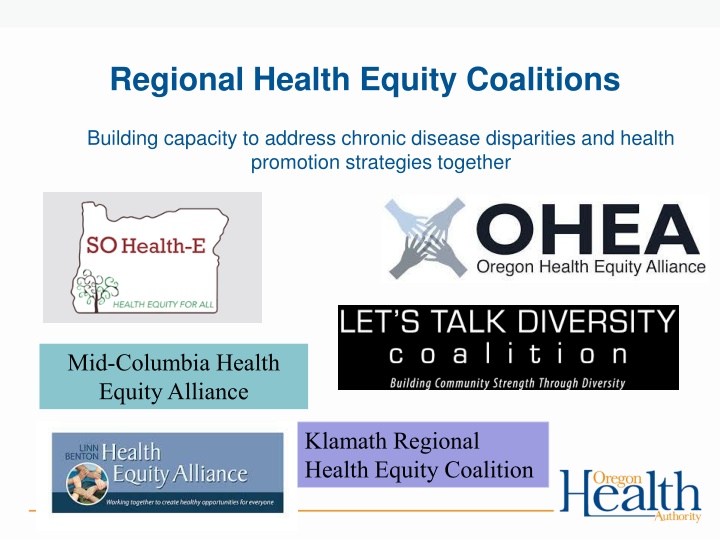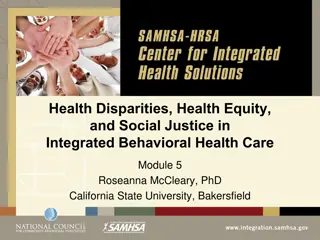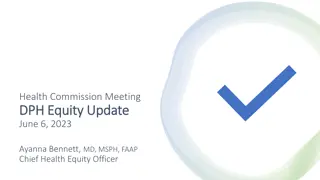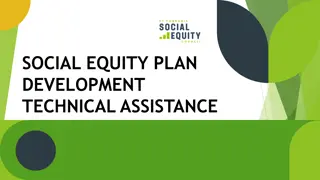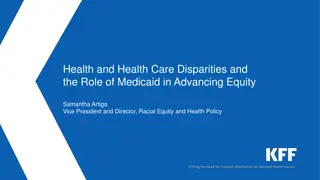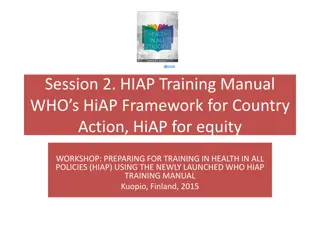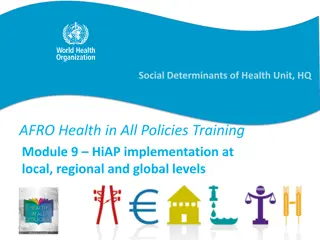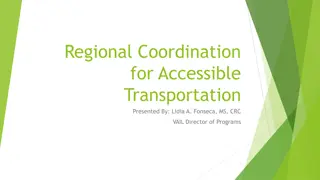Regional Health Equity Coalitions
Regional Health Equity Coalitions are collaborating to address chronic disease disparities and promote health strategies. Evaluation findings highlight the importance of funding and stronger relationships for successful community-level change processes.
Download Presentation

Please find below an Image/Link to download the presentation.
The content on the website is provided AS IS for your information and personal use only. It may not be sold, licensed, or shared on other websites without obtaining consent from the author.If you encounter any issues during the download, it is possible that the publisher has removed the file from their server.
You are allowed to download the files provided on this website for personal or commercial use, subject to the condition that they are used lawfully. All files are the property of their respective owners.
The content on the website is provided AS IS for your information and personal use only. It may not be sold, licensed, or shared on other websites without obtaining consent from the author.
E N D
Presentation Transcript
Regional Health Equity Coalitions Building capacity to address chronic disease disparities and health promotion strategies together Mid-Columbia Health Equity Alliance Klamath Regional Health Equity Coalition
HPCDPs Evolving Relationship with RHECs Opportunities: RHECs will inform HPCDP 5 Year Strategic goal implementation plan through direct contracting relationship Mutual Capacity-building Implement promising and emerging practices to expand the evidence base for effective strategies to improve population health and equity. 2017- 2018: 2018- 2019: Focus on Tobacco and Alcohol Prevention Add Nutrition and Physical Activity Focus 2
Evaluation of Support Needs Among Oregon Regional Health Equity Coalitions Evaluation Questions: 1) How has using a coalition structure affected HPCDP s ability to engage community-based organizations in health equity initiatives? 2) What facilitating factors offered by HPCDP have supported, or not supported, RHECs to successfully participate in public health related policy change? 3) How and how well are RHECs functioning overall, and in the process of engaging successfully in public health related policy change? 3
ORI Evaluation of Support Needs among RHECs Main Findings Each RHEC has a unique structure Highest priority for all 3 = Funding HPCDP can build stronger relationships with RHECS and a deeper understanding of community level change process 4
RHECs described facilitating factors offered by HPCDP that have supported, or not supported, RHECS ability to successfully participate in public health policy change process What can the State do? I think the State s solution often is Oh, we ll give them technical assistance. We ll give them no offense consulting. When what we really need is support. It s organic because relationships get developed so if you are not sinking investment into those relationships, you re not really going to get change to happen. Or even understand what change needs to happen. RHEC Leader It depends, developmentally, where different coalitions are and different communities in terms of readiness, ability and capacity. It s not going to be one size fits all. - RHEC Leader 5
All RHECs discussed doing the hard work of systems change, and the need for a long term commitment to health equity. Systems work is really long and hard. It s very hard when year after year, systems are saying oh we have an equity plan it s in draft . Another year passes where s that equity plan? Oh it s still in draft. We re working on it. RHEC Leader RHECs identified the desire for HPCDP to support their communications. Messaging tools are always helpful. How do you message to diverse populations, or diverse policy-makers? And what resonates for those policy-makers is important to know. And how you frame it in such a way that regardless of red, blue or purple, state or county you re talking high-level values. That kind of messaging could be helpful for us. RHEC Leader 6
..having more tangible partnerships with criminal justice, education, and all these sectors we know impact someone s health. RHECs doing that has been incredible in that they have a lot of success in showing OHA they are meaningfully bringing and adding value to the table compared to the Community Advisory Councils (CACs). They are bringing different groups and different voices to the table. Other community coalitions are brought together to represent community needs, but they aren t always engaging community groups effectively in decision-making and policy change. OHA relies on the RHECs to do the work that develops deep quality improvement in the State s health. - HPCDP Staff member 7
Recommendations for HPCDP Data and Surveillance Capacity-building Relationship-based Develop materials in tandem with RHEC goals Closer Relationship with RHECs Streamline access to data that RHECs need for their local/regional chronic disease prevention and health equity work Maintain shared tobacco prevention efforts, but also leverage RHECs to increase other areas of health promotion resources Development of communication channels to inform statewide transformation efforts Foster stronger partnerships between county public health and RHECs Conduct a formal needs assessment to determine gap of current state and desired state Move beyond traditional concepts of technical assistance Foster RHEC Peer relationships 8
Table Conversation What are facilitating factors offered by HPCDP that will support you this biennium to successfully implement PSE strategies aimed at tobacco prevention and alcohol prevention within your communities? What are facilitating factors to support partnerships and collaborative efforts to advance health equity and public health policy change? 9
